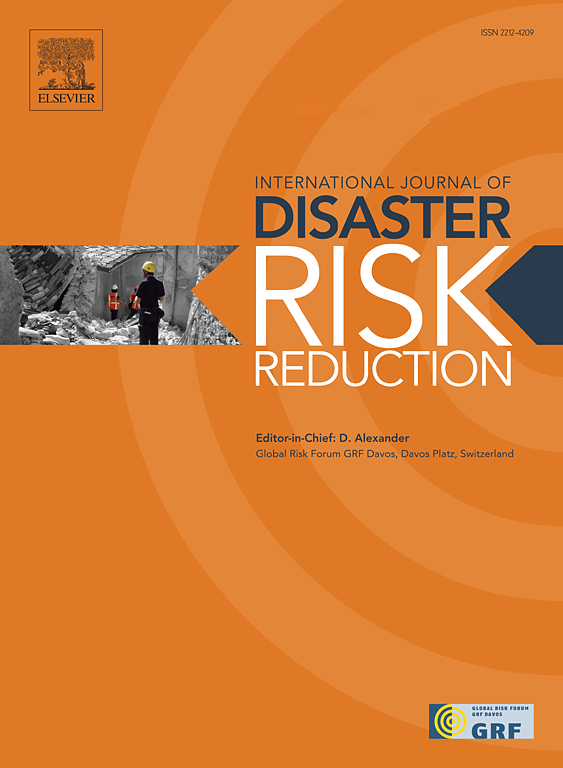通过减缓流域系统缓解洪水脆弱性:以印度尼西亚班加万索罗河为例
IF 4.2
1区 地球科学
Q1 GEOSCIENCES, MULTIDISCIPLINARY
International journal of disaster risk reduction
Pub Date : 2025-06-04
DOI:10.1016/j.ijdrr.2025.105629
引用次数: 0
摘要
洪水是最严重的全球性灾害之一,造成严重的社会、经济和环境影响,特别是在河流地区。滞洪盆地是一种有效的防洪措施,可以在洪峰期间暂时储存多余的水,从而降低下游的洪水风险。本研究通过分析印度尼西亚班加万梭罗河的一部分拉蒙根县的Jabung Retarding盆地来研究这一概念的应用。目的是评估该流域在实施前后减少洪水范围、深度和相关经济损失方面的有效性。利用HEC-RAS 6.5和ArcGIS 10.3,对10年、20年、25年和50年的汛期进行洪水淹没制图。结果表明:贾邦拦阻盆地使洪水影响面积减少了39.72% ~ 42.69%,其中淹没深度超过1.50 m的地区减少幅度最大;但对平均洪水深度的影响有限,运行后从1.036 ~ 1.046 m略微下降到0.995 ~ 1.031 m。除了减少洪水范围外,该流域还显著降低了经济损失。例如,以前一次50年一遇的洪水造成的估计损失约为955万美元,在行动后减少到589万美元。虽然这项研究是针对特定地点的,但研究结果表明,滞洪盆地可以为其他洪水易发地区或三角洲地区的综合洪水风险管理做出贡献。所采用的方法可以适应类似的水文和社会经济情况。未来的减灾工作还应考虑对下游的影响,包括提高泄洪能力、优化排水系统和实施预警系统。本文章由计算机程序翻译,如有差异,请以英文原文为准。
Mitigating flood vulnerabilities through retarding basin systems: A case study in Bengawan Solo River, Indonesia
Flooding is one of the most significant global disasters, causing severe social, economic, and environmental impacts, particularly in riverine regions. Retarding basins are effective flood mitigation measures that temporarily store excess water during peak flows, thereby reducing downstream flood risks. This study investigates the application of this concept by analyzing the Jabung Retarding Basin in Lamongan Regency, part of the Bengawan Solo River, Indonesia. The objective is to evaluate the basin's effectiveness in reducing flood extent, depth, and associated economic losses before and after implementation. Using HEC-RAS 6.5 and ArcGIS 10.3, flood inundation mapping was conducted for return periods of 10, 20, 25, and 50 years. The results show that the Jabung Retarding Basin reduced the flood-affected area by 39.72 %–42.69 %, with the most significant reductions observed in areas where inundation depths exceeded 1.50 m. However, its effect on average flood depth was limited, decreasing slightly from 1.036 to 1.046 m to 0.995–1.031 m after operation. In addition to reducing flood extent, the basin significantly lowered economic losses. For instance, a flood with a 50-year return period previously caused an estimated loss of approximately $9.55 million, which decreased to $5.89 million post-operation. Although this study is site-specific, the findings demonstrate that retarding basins can contribute to integrated flood risk management in other flood-prone or deltaic regions. The methodology employed can be adapted to similar hydrological and socio-economic contexts. Future mitigation efforts should also consider downstream impacts by enhancing floodway capacity, optimizing drainage systems, and implementing early warning systems.
求助全文
通过发布文献求助,成功后即可免费获取论文全文。
去求助
来源期刊

International journal of disaster risk reduction
GEOSCIENCES, MULTIDISCIPLINARYMETEOROLOGY-METEOROLOGY & ATMOSPHERIC SCIENCES
CiteScore
8.70
自引率
18.00%
发文量
688
审稿时长
79 days
期刊介绍:
The International Journal of Disaster Risk Reduction (IJDRR) is the journal for researchers, policymakers and practitioners across diverse disciplines: earth sciences and their implications; environmental sciences; engineering; urban studies; geography; and the social sciences. IJDRR publishes fundamental and applied research, critical reviews, policy papers and case studies with a particular focus on multi-disciplinary research that aims to reduce the impact of natural, technological, social and intentional disasters. IJDRR stimulates exchange of ideas and knowledge transfer on disaster research, mitigation, adaptation, prevention and risk reduction at all geographical scales: local, national and international.
Key topics:-
-multifaceted disaster and cascading disasters
-the development of disaster risk reduction strategies and techniques
-discussion and development of effective warning and educational systems for risk management at all levels
-disasters associated with climate change
-vulnerability analysis and vulnerability trends
-emerging risks
-resilience against disasters.
The journal particularly encourages papers that approach risk from a multi-disciplinary perspective.
 求助内容:
求助内容: 应助结果提醒方式:
应助结果提醒方式:


